Final report for FNC17-1095
Project Information
My project remains the same as stated. I will hold workshops and provide online training to assist livestock producers in using and benefiting from stock dogs. The workshops will provide hands-on training for both the handler and the dog to gain skills and understand how to train and use the dogs to manage livestock in a stress-free manner. The online discussions and video training will enable me to post videos to help learn skills or fix a problem. I will critique videos from producers giving my advice. I have set dates for the fall 2017 and spring 2018 workshops. There has been a facebook page set up and I have begun reaching out to livestock/ ag affiliated groups to advertise to members. I am advertising in two magazines currently as well as online ag groups. I have also begun a handout for the workshops.
Problem
Producers manage their stock within unique constraints that limit the sustainability of their operation. Constraints include time, skilled labor, land, adequate facilities and fencing. Physical limitations and lack of understanding of livestock movement and behavior also limits producers’ success.
Off-farm employment and caring for young children limits producers’ time to devote to livestock care. Producers with grown children exit livestock production because they don’t have the available labor to care for stock. The physically stressful and demanding nature of livestock production can discourage women, physically challenged and older producers causing them to exit the industry or not enter.
In the Midwest thousands of acres that could support livestock are not grazed. Crop fields are not grazed after harvest. Hilly or wooded land is regarded as unusable. Well-managed livestock can concurrently improve land health (targeted grazing has been shown to reduce weeds, increase soil fertility, and allow managers to meet specific biodiversity and production goals) and improve the sustainability of operations by diversifying enterprises and improving profitability.
Sheep and goat production requires relatively little initial investment for infrastructure and can be maintained with little added input thus providing an entry point into agriculture. The trade-off is small ruminants require more hands-on management than other livestock. Stockdogs can be key to profitability by enabling timely, humane and safe handling of sheep and goats. A dog replaces several people, saves thousands of steps a day, and reduces fuel, equipment repair and maintenance costs. Stress is a major concern among producers. Working alone for hours takes a toll, but a well-trained dog provides a silent, willing, skilled, dependable ‘working partner’ that adds emotional support to the tangible benefits they provide. Having the skill to use well-trained stockdogs addresses many constraints opening up possibilities for each operation to participate in sustainable agriculture.
Solution
This is a personalized three-part educational program to introduce livestock producers to the benefits of stockdogs through demonstration, enable skill building through hands-on learning during workshops and provide continued learning and support through discussion and video instruction after the workshop.
I will use experienced stockdogs to demonstrate ways stockdogs are used to assist in the care of stock. Participants will see how the individual skills of gathering, driving and holding stock work together in an operation. Young dogs will demonstrate instinct, the progression in learning and the handlers’ role in training. Each participant with a dog will work with the clinician twice a day on the skills they need to perfect. They will then work alone building their understanding of and confidence in the skills learned.
I will offer continued support for one year after workshops. I will design an internet discussion forum where videos can be posted that I will critique. I will post videos taped to personally address questions asked, demonstrate needed skills and suggest ways to achieve success. I anticipate spending 12 hours a month throughout the year providing this on-going support.
I anticipate 100 people attending the on-farm demonstrations (one will be focused on youth), 8-20 producers participating in each workshop with 10-25 additional producers participating on-line.
Participants wanting to figure out if a herding dog will be a good addition to their operation will able to work my dogs on stock enabling them to get a feel for doing chores with the assistance of a dog and learning basic dog-handling skills. They will leave knowing if they want to obtain a stockdog and have assistance finding one that suits them and their operation.
My farm will serve as a hub for educating producers about all aspects of incorporating stockdogs successfully into livestock operations.
CONCLUSIONS
The workshops provide the most beneficial method of learning enabling both the handler/producer and the dog gain practical skills through hands-on practice. The more training opportunities offered and taken advantage of the more thoroughly skills are understood and learned to allow producers to benefit from their dogs. The advanced skills of having a dog hold stock away from feed bunks, sorting individual animals while on pasture for medication/deworming/ moving to barn..., pasture lambing etc require foundational skills and understanding to be in place. The workshop format allows each producer and dog to advance at their own pace. It also enables everyone to learn as they watch the instruction for others.
1. Improve land health and sustainability of operations in livestock management practices by using stock dogs.
2. Educate livestock producers on the benefits and training of stock dogs through demonstration, hands-on workshops, and online materials.
3. Enable more sustainable practices in livestock management using stock dogs including rotational grazing and less need for gas-powered equipment.
4. Help farmers improve their livestock management practices using stock dogs to increase time efficiency and reduce stress to people.
Cooperators
Research
I have held clinics for several years always attempting to inform livestock producers of the benefits, uses, and training of stock dogs. The SARE support has enabled me to make the clinic more affordable to producers as well well as reach out to more producers. The “marketing” has always been a challenge and continues to be. Using traction I have gained in the past couple years as a freelance agriculture writer has helped. My name is more widely known. My articles on stock dogs has helped me be seen as very knowledgeable. Writing specific articles articles about stockdogs has been helpful to foster interest. Many folks contact me by email and phone which has required considerable time. I am also checking in with workshop participants occasionally to ask if there is any roadblocks in their training and use of their dog that I might be able to offer suggestions. This also is time consuming but very well received and needed to further their success. Lots of leg work and coordination is needed to get ready for the clinic. Advertising, following up with interested folks, letting them know what they will need to bring, and preparing for lunches. The pastures are all checked, holes filled, fences and gates fixed or adjusted to ensure safety of stock and participants. All vet history of dogs coming is double checked. emails sent as a reminder of how things are organised, what they should prepare for and bring. Once the clinic is here I do all my chores before the clinic, make breakfast for those staying on the farm and have sheep moved to places they will be needed. During the clinic I move stock as needed and take care of any questions or concerns. After the clinic more chores and prep for the next day.
Participants filled out a survey before and after the first workshop to see what they found the most useful and where we need to add information. We are adding a special demonstration afternoon prior to the second clinic allowing for in-depth discussion to occur. We are also planning a social event one evening to enable more interaction.
Educational & Outreach Activities
Participation summary:
Edited-swswhandout-for-SARE-final-notes
SGF-Skilled-Employees-Working-For-Room-and-Board
Stock-Dogs-Employed-by-Two-KY-Cattlemen
Herding demonstration at Henry Co Harvest days July 29th, flyer advertising Workshops
Herding demo scheduled April 26th in conjunction with clinic #2 April 27 - 29 2017
Articles appearing in Stockman Grass Farmer, Acres USA, Sheep and Cow Country News in 2018 to promote workshops and consultation/training video opportunities. Other articles submitted to the American Sheep Industry, and cattle organizations. Notices were posted on many ag related facebook sites.
Flyers sent to extension offices, vet clinics, farm stores, livestock markets, feed stores, livestock assoc.
Videos used to advertise on facebook
On going education as requested - Demo / discussion March 2019 at Indiana Small Farms Conference
Skill Building and Workshops continuing this year beginning in April 2019.
Announcement in Sheep Magazine for SARE supported workshops.
Learning Outcomes
One sheep producer learned specifically at the 2017 fall clinic that stock dogs need the correct instincts to be of greatest benefit. She had brought two Ausssies to the clinic. Working these dogs and a Border Collie of mine showed her the difference breeding makes in their ability. She has purchased a trained dog through the clinician several months later. She is in the process of expanding her flock and going to a pasture lambing system enabling her to enrich her land at the same time her flock is growing. A stock dog understands stock movement and the stock understand a good dog making management of the stock easier. The Immediate respect livestock have for an experienced dog changes their attitude from day one. It is like they just enrolled in boot camp and now walk the line simply because of the dog's presence.
Many other producers have been investing time and training in their dogs using methods learned at the clinic. The workshop training is different than most stock dog training since we stress using the dog's mind and instincts to work stock rather than teaching the dog commands from obedience perspective to do as asked then work stock like the person feels is correct.
Most producers that attended the first workshop joined us again at following workshops to continue learning and advance the training on their dog.
Producers heard of the workshops calling for training advice and more information on training opportunities even if they were unable to attend the clinics. Phone calls came from all across the country - MO, MT, KS, TX, CA, CO, WA, WI, OR, SD, ID, IL, IN, IO, KY, OH, NY, PA, VA. It always amazes me how HUNGRY producers are for practical information that will enable them to benefit from the use of stock dogs in their operations. It shows me we need to continue to offer these workshops as well as come up with other ways for producers to learn.
Several producers called and some attended the training who are interested in livestock and stock dogs but do not yet have either. They attended to gain a better understanding as part of researching and making decisions. JF from NY flew to the Sept 2018 clinic to watch the dogs work and discuss his options moving forward with the goal of purchasing both sheep and a stock dog for a commercial sheep operation. Other producers, I spoke with at length on the phone. Some had invested in a stock dog, a pup or even trained dogs, but were struggling to understand the training. Some I believe honestly did not have the right dog for the job. Many people will sell a dog but few take into consideration it has to be the right dog for the person and the work they have. Speaking with folks I try to make them aware that not every herding dog is going to do the work they need and many are not suited for a novice handler. The workshops bring this point home, everything has to click and producers have to willing to learn and ask for help in order to benefit the most from good stock dogs.
In addition to simply educating producers about the training and work that goes into having a useful stock dog there are practical considerations that need to be addressed. First off is how to let producers know of opportunities to learn. Social media and the internet has made this easier but it still takes an extraordinary amount of commitment and time to reach out to folks. Next is not everyone is able to travel very far from home. It would be best to provide opportunities for workshops in different parts of the country enabling more participation. This is complicated by the fact that organizing these workshops takes quite a bit of time and needs adequate stock and facilities, places for participants to stay and eat as well as available experienced folks to teach at these locations.
I dealt with these challenges by not only using the internet and social media to advertise the workshops but also sent flyers and contacted ag groups, extension educators, livestock auctions, vet clinics...anywhere I thought could reach producers. This helped spread the word which was evident by the phone calls I received from across the US. I tried to have the dates of the clinic vary some to allow more folks access. Adding addition skill building days were added where I could help individuals. These proved worthwhile enabling producers and their dogs to learn and improve. I also was able to pass on dates and other locations of clinics put on by Jack Knox. While these clinics did not cater to livestock producers and did not have the practical discussions we were able to have because of those attending or the networking with other producers as extensively I am sure they learned needed skills.
The advantages of workshops similar to the ones I held at Clearfield Stockdog and Lamb is the hands-on learning that takes place over multiple days with experienced, practical training being taught. Not only are producers able to work their dogs if they brought one but they benefit immensely from working with my dogs giving them a deeper understanding and respect for the dogs that would not have been gaining without that. They are able see chores being completed and the training used to enable this to happen. I believe networking and knowing they can call me or others with a question is extremely valuable to further their learning. Also having multiple workshops several times a year gives them the support and offers more advanced training as they are ready for it. The workshops themselves allow for each person to learn from every other handler and dog so lessons are reinforced and they see things that will help them later in their own journey.
The added skill development days allowed producers the time and individual attention needed to address either concern, problems or questions. I was able to spend the time with them and their dog to help them through the issues. I was able to assist them working a more experienced dog of mine if I thought that would shed some light on the problem as well. These added days were used to cement a better understanding of how to use and train the dogs. These days further advance both dog and owner along that journey to becoming proficient at training stock dogs for low stress management of stock.
I believe more education opportunities need to offered to address the need and interest of producers. Hired help is expensive and often not available. A stock dog can do the work of several people and is always available. No matter the time of night, weather or length of working day they are eager to help. Producers are able to manage more stock with less effort and time and less stress. A win for all. Additional training needs to be offered in a hands on and a virtual manner. More hands on clinics with qualified instructors teaching low stress stock handling while incorporating stock dogs would be ideal. On-going newsletters and video critique and video instruction would be helpful between workshops or for those who have trouble traveling. A mentoring network across the country with those experienced handlers who are also livestock producers willing to help others would be a great addition to workshops. I hope to continue making strides to provide these educational and training opportunities.
Project Outcomes
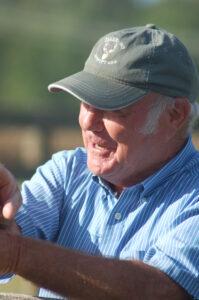
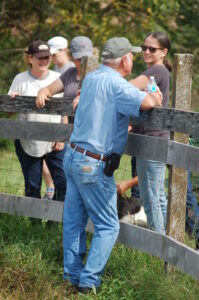
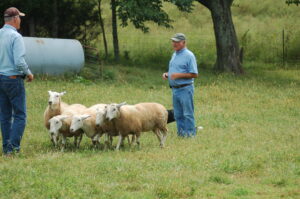
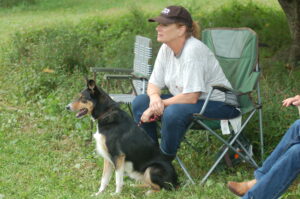
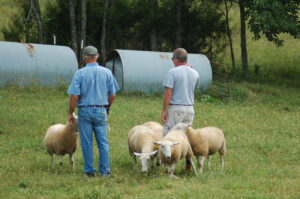 The first workshop had 19 livestock producers participating. Those participants raised sheep, cattle and poultry; two of which have dairy cattle. Most participants learned that it takes a dog with instinct and ability bred into the dog - instincts - to work stock. They realized they needed the right tool (dog) for their operation and that training can not make up for the dog's lack of 'want to' and built-in knowledge. SC of northern IN said "I now see with the right dog the growth potential of my operation is unlimited." SC purchased a trained working Border Collie to assist her with her flock as a result of the first workshop. After 1 week she reported less stress on the sheep and family members because Miles was able to assist her with chores. She is expanding her flock because she has the help she needed with Miles. Her husband is also getting "ewes of his own" because he enjoys raising sheep more now. " Miles has decreased the work load, cuts time for chores in half and makes everything more enjoyable."
The first workshop had 19 livestock producers participating. Those participants raised sheep, cattle and poultry; two of which have dairy cattle. Most participants learned that it takes a dog with instinct and ability bred into the dog - instincts - to work stock. They realized they needed the right tool (dog) for their operation and that training can not make up for the dog's lack of 'want to' and built-in knowledge. SC of northern IN said "I now see with the right dog the growth potential of my operation is unlimited." SC purchased a trained working Border Collie to assist her with her flock as a result of the first workshop. After 1 week she reported less stress on the sheep and family members because Miles was able to assist her with chores. She is expanding her flock because she has the help she needed with Miles. Her husband is also getting "ewes of his own" because he enjoys raising sheep more now. " Miles has decreased the work load, cuts time for chores in half and makes everything more enjoyable."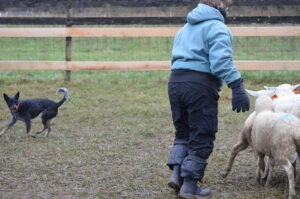
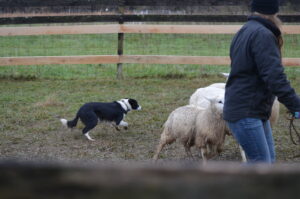
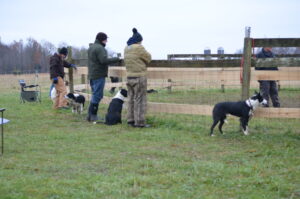
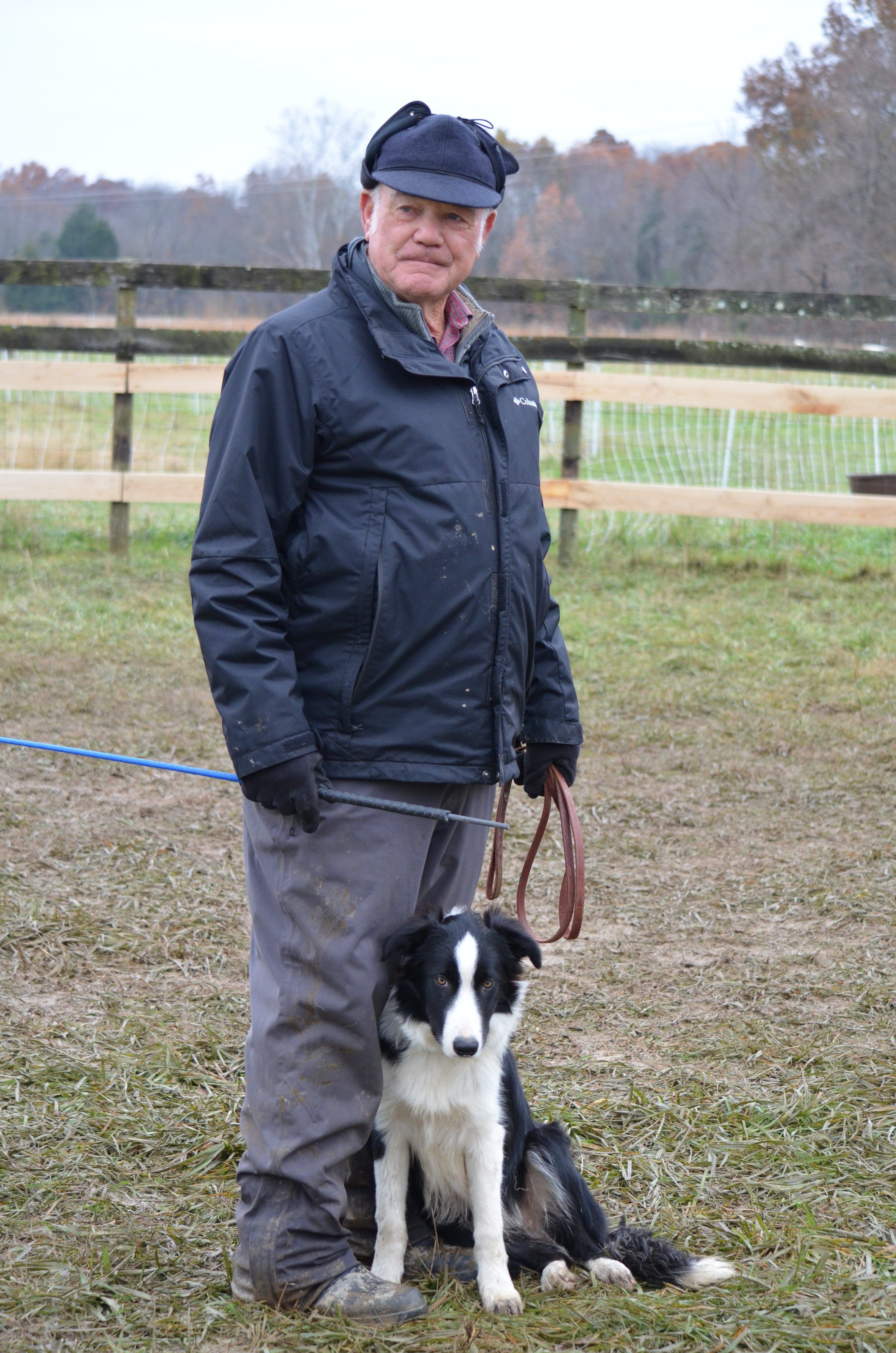
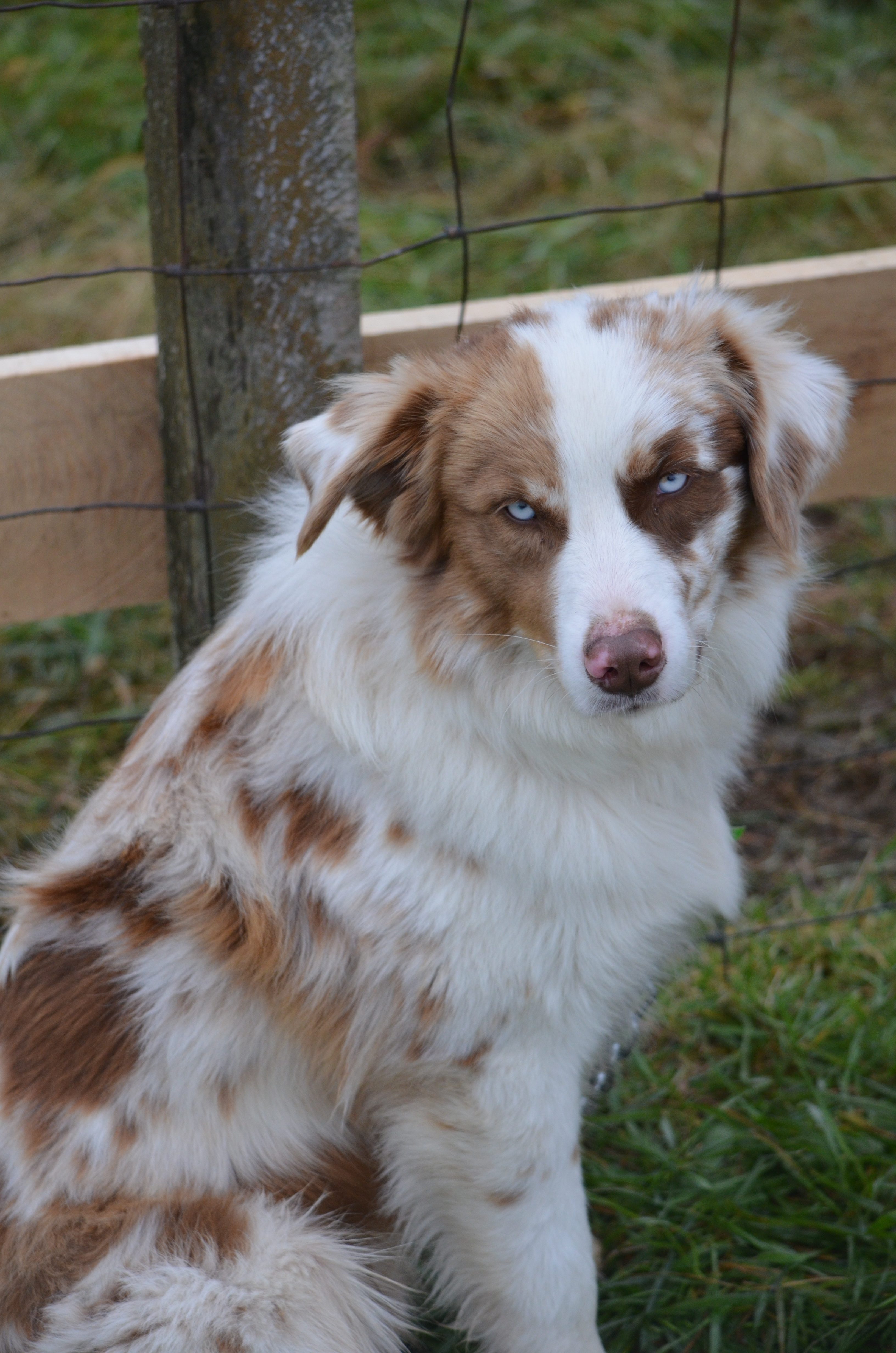
DH in western Indiana bought a started Border Collie because of the workshops. The dog is now daily helping her feed beef cows. She is wanting to expand into sheep production. Both are planning to attend the second workshop in April 2018 along with several other producers that attended last fall.
CO called asking for training advice several times in the fall/winter of 2017. She has a young Border Collie she is training for work on her PA family farm. She was referred to specific videos in order to picture what needed to be happening during training at home and was asked to take video of her dog working so I could be of further assistance.
KS of southern SD called with a training problem and was pointed in the right direction. Several follow up emails gave her more suggestions on how to proceed.
The second workshop in April 2018 was attended by 12 repeat participants to further develop their skills and 9 new participants. Almost all attendees have had working dogs less than 2 years and are needing a basic understanding of how dogs benefit a livestock operation and basic training for their dog and themselves to get them started in the right direction. The producers were split nearly evenly between those that have cattle and those with sheep. A few participants attending did not yet have a dog. They came to research and learn, making contacts that can be used in the future.
The added demonstration day severed to allow producers to see dogs accomplishing everyday chores to help them envision all the ways stock dogs can be utilized in their operations. The demo also brought home the point that training for both producer and dog is needed in order to gain the most benefit. Ample time was set aside for questions and discussion allowing participation from all.
Between the April and Sept workshops, I offered several days where folks interested in stock dogs or those with stock dogs could come to the farm for hands-on instruction. The number of participants varied from 2 to 12. The time spent breaking down questions, showing them how I accomplish chores and training with my dogs, and allowing them to work with a dog of mine all helped them to have a plan for training and accomplishing chores at home. Knowing what to look for and what to correct is key. Realizing that if their dog is trying they need to reward that try and possibly change their position to further help the dog understand the task. These small realizations are key to success.
The third workshop in Sept was attended by 16 producers, 3 of which were first time attendees of these SARE supported workshops. The most prominent advantage to having multiple clinics in a short time period is that the handlers and the dogs advance in their understanding and skill level. This clinic proved that point without a doubt. JF flew in from New York to observe and learn. He is fencing his property with plans on adding a commercial flock and sheep, selling lambs privately and buying a trained stockdog to assist him in managing his flock. During the clinic he benefitted from working two of my dogs on stock with the assistance of the clinician.
The last clinic proved that multiple workshops in a year, supplemented with days of group lessons where individual help was received enabled handlers and the dogs to progress in training and understanding of skills needed to use a stock dog to assist managing stock. Each and every handler and dog made remarkable advancements toward low-stress stock management.
After the fall workshop in Sept the farm was again opened to provide further training most weekends in Oct and Nov. Again the number of participants varied week to week. Most workshop participants spent at least 2 more days learning and training. In addition, several first-time participants attended who could not work the clinic into their schedules. BP came from OH with his first stockdog, Shep young BC. They spent most of the day here to observing others work dogs, working several dogs of mine in addition to getting his dog started on stock. My dogs were able to provide the hands-on training experience along with giving him confidence and understanding that working with an experienced dog brings. B was able to see and feel the outcome he was looking for by working several dogs at different stages of training. I also assisted him in introducing Shep to stock that day with two shorter follow up lessons through the day. KO joined us, flying in from VA to spend the day. She watched and learned then worked her first dog, a nice young dog of mine, with our assistance. JW attended the April 2018 clinic then drove up from KY to spend an afternoon here in Nov learning more about stock dogs. He brought up his dad's retired 12 yr old dog which had not been used on stock for 6 years. I demonstrated several dogs of varying ages and training to give J an idea of what he needed to look for in his dog indicating that he would be comfortable with working cattle. Many people have the mistaken thought they can train a pup when actually they have no idea how to begin. Giving them a young dog to work proves they are better off investing in a trained experienced dog who can get the job done and teach them as they work together. This small experience of attempting to work a young dog here saves producers a ton of time, money, and frustration fumbling with a pup at home but getting nowhere. It can put them years ahead of where they would be on their own and give then contacts and mentors to help them in the future.
In the Midwest, livestock operations vary considerably. Some operations are large enough to support full-time employment but most sadly do not generate sufficient income. Most producers are actually first generation livestock producers so these folks are very enthused and positive about the future but do not have the education or background experience with livestock. It is a bit of a double-edged sword since they could benefit from lessons on how livestock think and act, the way they move like they do, how our positioning and interactions affect the stock and good management practices. Working with a diverse group in the workshops including those that have grown up around stock is helpful since the producers learn from one another. I do feel that a day spend concentrating on low-stress livestock handling would be especially beneficial. Hands-on opportunities with stock are especially limited in this area. This type of education would benefit producers every day no matter what stock they raise helping the operation be more profitable, productive and safe.
I do feel that while on going hands-on education is paramount to learning how best to manage stock and how best to gain the most assistance from a stockdog we need to explore other avenues of training to supplement this hands-on education. Video instruction needs to continue to be explored, a newsletter or other timely ongoing publication could be very useful as could workshops designed for producers held across the country.
Working stockdogs to provide low-stress assistance managing stock demands continued learning and advancement of skills. Each dog is different and they each progress through training uniquely as do people. Working with a dog as it matures and learns enables you to ask for more advanced skills from the dog but also requires more understanding on the handlers/livestock managers part. Every training technique gained and understood as well as the continued understanding of how dogs work and think adds another tool to the handlers tool belt to use when needed. During the course of a day using a dog to assist with chores adjustments can be made to improve success if you recognize where the dog might need help. Dogs (and people) learn, change, and gain skills for many years so it is imperative to provide continued support and education for both dog and handler. The more the handler knows and understands the better the outcome will be. Dogs working with a confident competent handler relax, this relaxes the stock so everything flows much easier with little stress. Handlers that are uncertain create dogs that are concerned due to inconsistent training, incorrect commands, unfair expectations, wrong positioning, and poor timing of corrections. This leads to frustration and stress of all involved. Ongoing hands-on education is needed to continue to develop skills enabling the most positive outcome for dogs, producers, and livestock.
Many think of stockdog when needing to gather or drive stock but these dogs are capable of assisting in every aspect of an operation not only gathering. Dogs can hold stock away from feed bunks making it safer to bring grain in, watch gates. Dogs can sort individual animals so the entire herd doesn't need moved through working facilities for one or a handful of animals reducing needless stress and saving time. Pasture lambing is possible, pulling lambs with ewes remaining in the pasture, sorting families for processing, moving families to new pasture to take advantage of the best forages all are easier with an experienced dog.
The more skills the dog and handler possess the more opportunities present themselves. No longer is your operation constrained by fences or building or equipment. The livestock can be managed - moved, medicated, birthed, fed - anywhere you and the dog can access enabling more sustainable and better use of land and resources.
I was surprised by the vast interest in attending these workshops evident by the phone calls and producers traveling from many other states and well as some flying in from across the country. This indicated that I am on the right track developing a hands-on opportunity for producers to learn to use stockdogs. We need to continue to try and offer this education at a cost that producers can afford, varry the times of year the worshops are offerend and try to offer more workshops across the country.